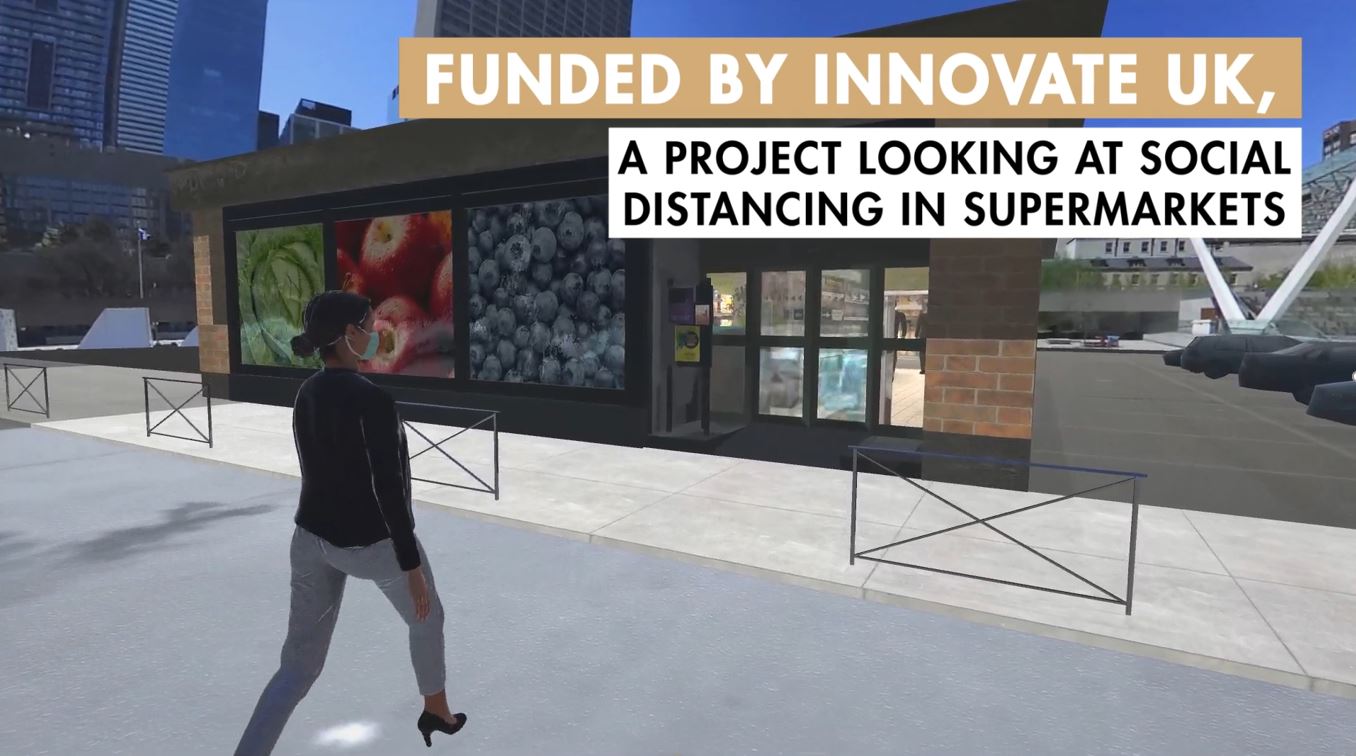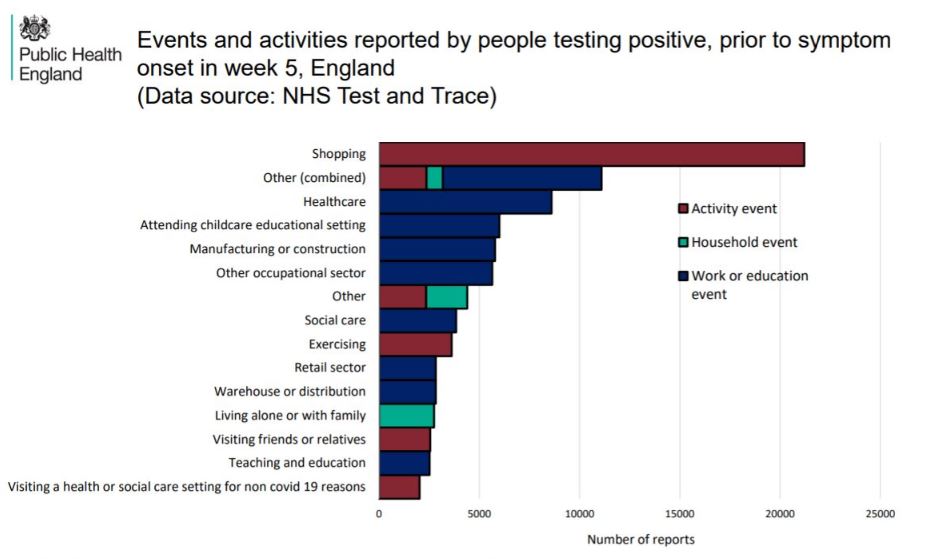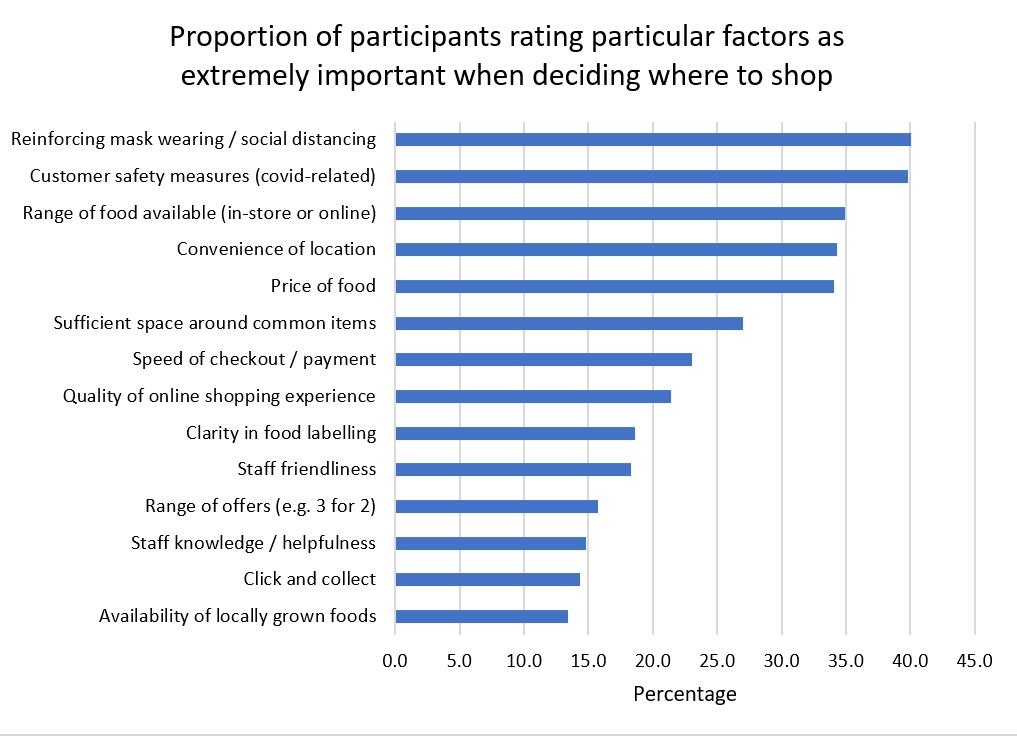

Introduction
Prior to March 2020, 'safety' was rarely a consideration when shopping for groceries. Covid-19 has changed all that. In our recent Shopping Habits Survey people respondents stated that customer safety is more important than price and location when deciding where to shop for food. So what are people concerned about, and what can be done to address these concerns?
Even at the height of a pandemic, when most of the country is in lockdown, people need to buy food (in fact, grocery purchases increased); as reflected in the Public Health England stats shown in Figure 1. Online shopping is perceived as a safer alternative, but still only account for about 15% of grocery purchases1; so most grocery shopping is still done in-store.

Figure 1: PHE Weekly Influenza and COVID-19 Surveillance graph for February 1st - 7th 2021 (link here)
Shopping Habits Survey
We conducted a survey in which over 1000 people took part. Figure 2 shows the factors that people currently consider to be most important when deciding where to shop.

Figure 2: Factors affecting where to shop (February 2021)2
It is striking that, even 12 months after the start of the pandemic, customer safety ranks more highly than price and location. And despite the vaccine roll-out improving shopper confidence, many commentators now expect Covid-19 to affect our lives for years to come. Not surprisingly, there have been calls (both domestic and international) to better prepare for future virus outbreaks. And recommendations for the grocery sector should naturally be addressed as part of that plan.
The perception of safety in-store
In terms of the perception of safety in supermarkets, figure 3 shows that customers perceive the main risk arising through other customers not wearing masks. They also perceive there to be a high risk from being too close to other people and from breathing in particles in the air. Consistent with this perception is the finding that 95% of participants believe that mask-wearing should be mandatory, and 90% are supportive of staff reinforcing guidance. These reflect the main risks identified by scientists: transmission of particles caused by coughing/sneezing; and airborne aerosols created just from breathing.

Figure 3: Perceived risk factors when shopping in store3
Participants also perceive there to be some risk, albeit lower, from contaminated surfaces. Interestingly, the risk attributed to items being handled by checkout staff is at the lower end of the scale, even though checkout staff handle every item purchased by every customer passing through their lane.
So how well did participants believe supermarkets had responded to the pandemic?
Satisfaction with current measures
Since the start of the pandemic, stores have introduced several changes including: limiting numbers in store; floor markings and signage; and mask wearing.
Figure 4 illustrates to what extent customers feel dissatisfied with certain aspects of in-store shopping during the pandemic.

Figure 4: Satisfaction with in-store Covid-19 measures4
In terms of dissatisfaction with in-store Covid-19 measures: at the lower end of the scale are hygiene measures and management of numbers entering the store; at the upper end of the scale are issues relating to enforcement of safety measures and social distancing. As one participant said: “Once people are in the store it's a free for all”. Clearly there is room for improvement in all aspects, but some things are easier to improve than others. Enforcement of mask-wearing and ensuring that trolleys, baskets, and checkout areas are cleaned rigorously would seem like straightforward improvements. On the other hand, reorganising the layout of the store is more challenging. As one participant said, “It would be good to have wider aisles, but I guess that isn't really possible”. In fact it is possible but would require more radical (and more costly), alterations.
Prior to the pandemic, it was to be expected that store layout and product positioning would usually be designed to maximise sales. However, at times when safety is the dominant factor, there will be an expectation that everything is being done to make grocery shopping as safe as possible.
Using Virtual Reality to identify problems and test solutions
To identify issues relating to social distancing in stores, and to explore solutions, we developed a computerised simulation for a small grocery store and a medium-sized supermarket (supermarket simulation). The power of virtual reality is that a store designer can experiment with alternative configurations and simulate the shopping experience in a safe and controlled manner. We programmed AI-controlled avatars to perform a shopping task to collect ten of the most purchased grocery items, and we observed where problems occurred. We also recruited 10 human participants to perform the same shopping exercise in the virtual stores.
The automated simulations led to several observations, including:
And from the user testing sessions the following observations were made:
Facilitating social distancing in stores
It would be natural to infer from this that supermarkets should re-arrange their stores to create wider aisles so that people have more space; and to ensure that the most popular items are not all placed in the same areas of the store so that clusters of shoppers are less likely to congregate.
The task of creating wider aisles incurs several practical and commercial considerations. In practical terms it would require moving shelving fixtures (known as gondolas) and the feasibility of doing this is dependent on the age and condition of the fixtures; the shelf profiles; and whether the fixtures are on wheels or bolted down. In commercial terms, there are costs in making such reconfigurations and it reduces the amount of merchandise on display. Consequently, stores may have chosen not to make such radical changes.
It might also be reasonable to question whether the number of customers allowed into larger stores is too high, especially as capacity calculations appear to be based on a false assumption that customers are evenly spread throughout the store. However, reducing the numbers allowed inside would have the negative side-effect of increasing the length of queues outside the store at peak times.
Re-purposing high street retail; and 'pop-up' shops
Measures to create more space in stores may lead to bigger queues for customers and less profit for supermarkets. Consequently there is an opportunity to increase the number of outlets selling common grocery items, so that customers can safely top up their essential supplies. This could be achieved in several different ways: retail concessions, re-purposing existing retail spaces; and 'pop-up' stores. Our survey supported this concept: when asked if they would be interested in using a pop-up store, designed with safety in mind, 71% of participants responded yes or maybe. Increasing the number of grocery outlets also reduces pressure on existing stores. So perhaps we will see the emergence of transmission-minimising convenience stores that enable people to do a top-up shop quickly and safely. Meanwhile, we would be delighted if supermarkets would get in touch to work through the findings of our project, and to discuss further analysis that could help them to navigate the ongoing effects of Covid-19 and prepare for future virus outbreaks.
References
2 Survey question: “For the following aspects, how important are they in influencing who you do your food shopping with right now? Please rate each factor on a scale of 1-5 where 1 is not at all important and 5 is extremely important”
3 Survey question: “What are the risks of catching covid-19 when doing your food shopping? Please rate each factor on a scale of 1-5 where 1 is no risk and 5 is a significant risk.”
4 Survey question: “On a scale of 1-5, where 1 is not at all satisfied and 5 is completely satisfied, how would you score your in-store shopping experiences since the beginning of 2021?”
Acknowledgements
Our project was commissioned by Innovate UK to investigate the specific issues surrounding social distancing in supermarkets. Thank you to Clare Montgomery of C A Design Services for information regarding the practical considerations involved in store layout, and to Damian Stevenson of DS Insight for organising the Shopping Habits Survey, February 2021.
Contact:
Graham Hutton (graham@bodyaspect.co.uk)